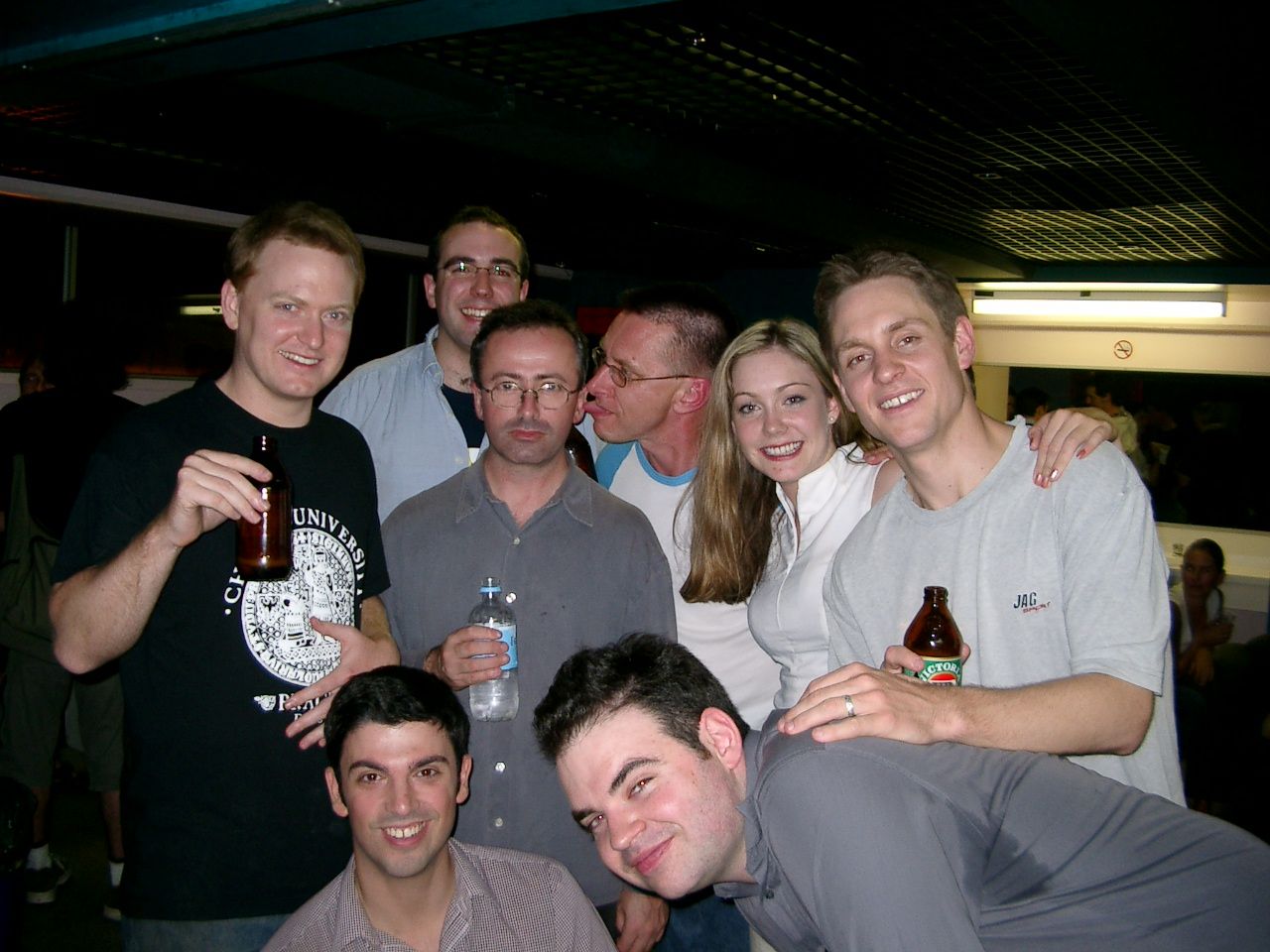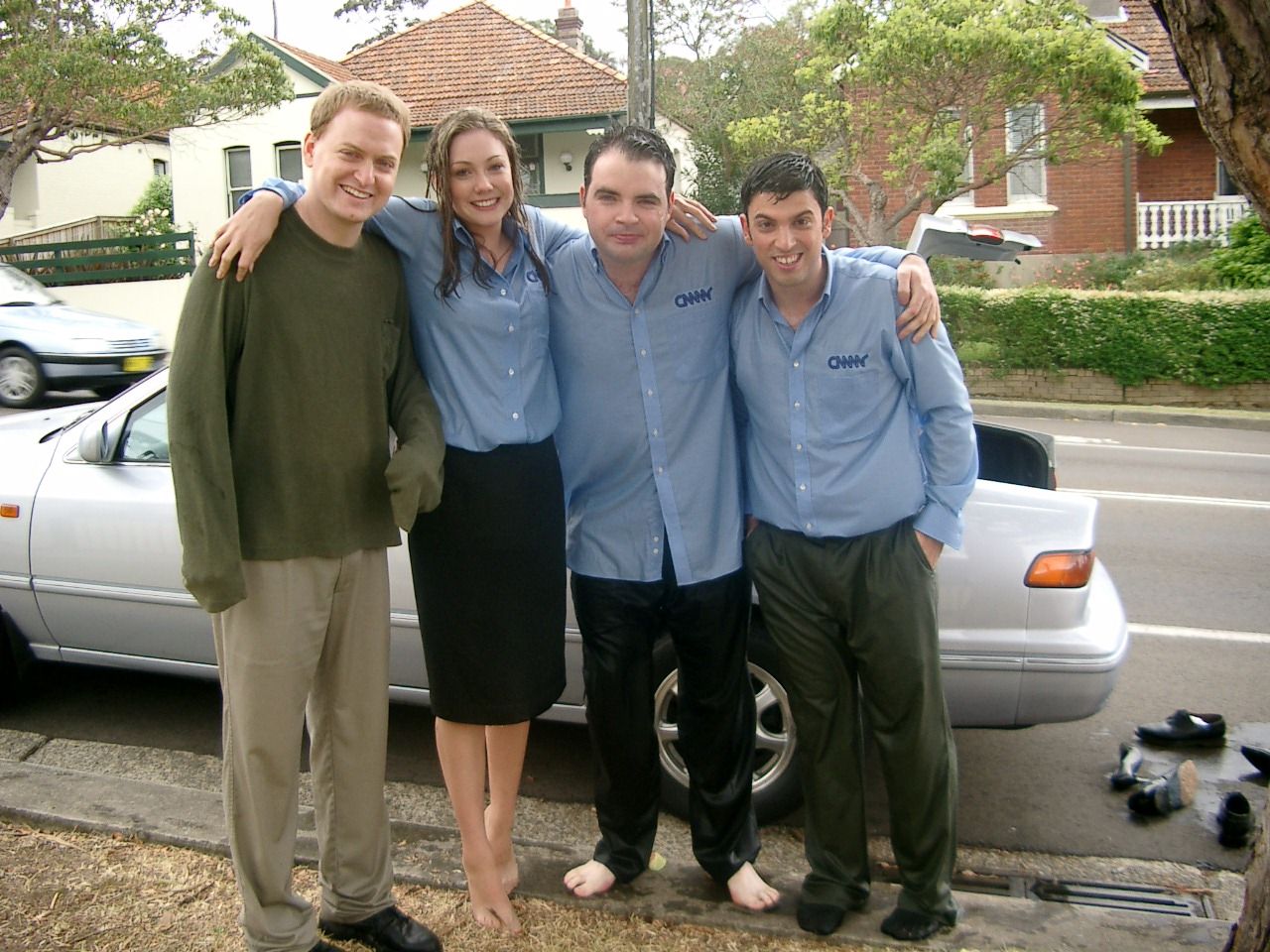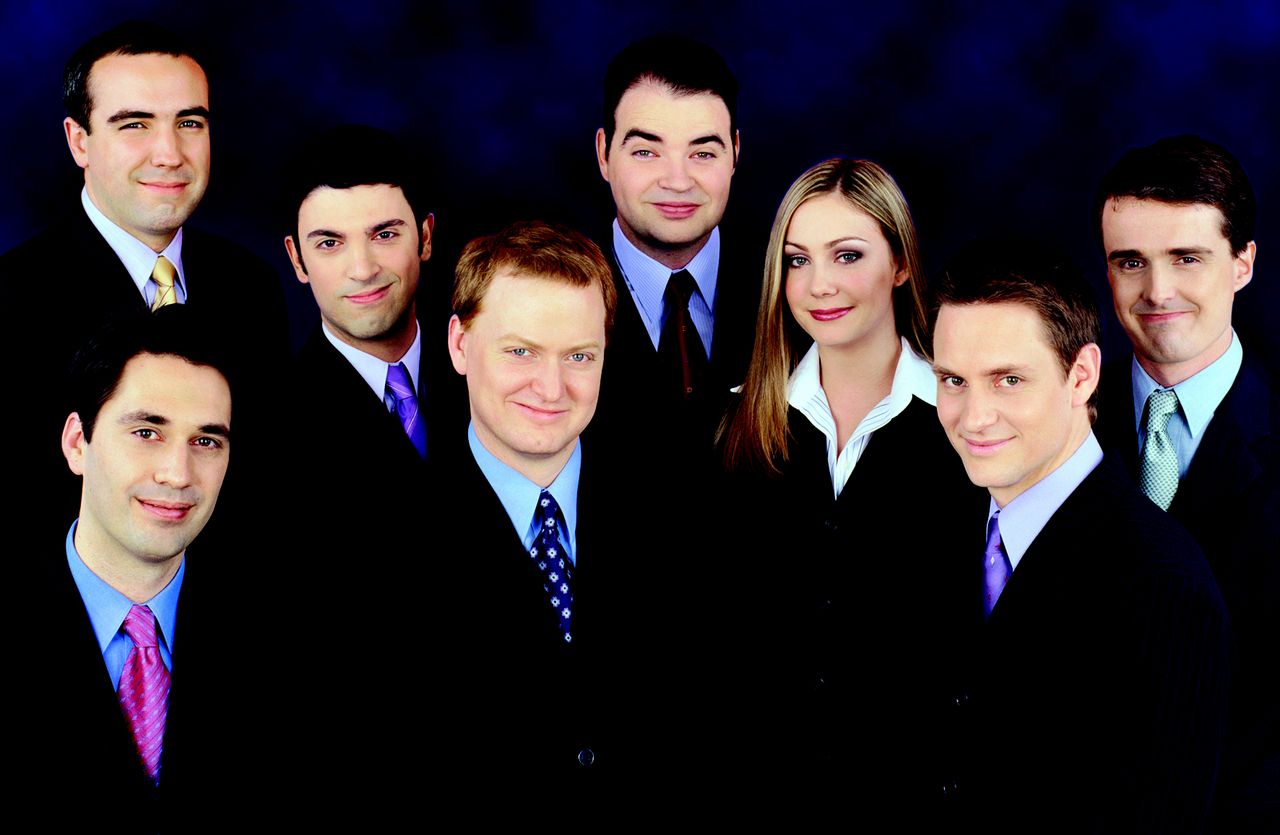
ORIGINAL CREW: a peek into The Chaser’s family album, featuring Charles Firth, Dominic Knight, Julian Morrow, Craig Reucassel, Chas Licciardello, Chris Taylor, Andrew Hansen and Anna Skellern. Andrew Denton was an early producer.










IN THE early days of The Chaser, whenever we were interviewed by someone from another newspaper, or a radio show or magazine, I would always slip in the detail that we tended to brainstorm in the pub. That the best headlines were fuelled by generous amounts of alcohol, and that they came to form scribbled on the back of beer coasters.
At the time, I wasn’t quite sure why I did this. Indeed, Craig used to get a bit irritated by the suggestion. Our creative process had little to do with any of the pubs nearby. The best ideas were almost always conceived in the office in impromptu chats that more closely resembled a team of wordwits trying to crack a crossword, than an unruly drunken brainstorm. The discussions were, if anything, embarrassingly intellectual – as much about what we wanted to say, as what the right gag was to achieve that end.

It’s not that we didn’t go to the pub, but that tended to happen after the newspaper was put to bed. And it is true that we enjoyed our beer. Indeed, to keep afloat in the early days, we had an increasingly frequent number of “fund-raising” parties, which involved us inviting our friends to the pub, and then charging them a small door fee for the privilege.
This happened from the very beginning. In fact, we held the first one on the night of May 8, 1999 – the night the first edition launched. We had completely underestimated the task of getting a newly designed newspaper out the door and pulled a couple of all nighters, delivering the files to the printers literally on the way to the launch party. We then headed straight to a Kinko’s on Broadway, printed out a few copies of the first edition on A3 paper, stapled them hurriedly together, and then headed straight to the Bellevue Hotel. It was a slightly inauspicious start, but rather appropriate given our later track record in the area of delivering on time. (Later in the night, a few of us ended up, drunk, at the printers, watching the first edition roll off the press).
Such parties were also an opportunity to make sure our friends were all subscribers. We had the launch party, we had a party to celebrate our 8th edition (which happened to coincide with an empty bank account), and then less than a month later, towards the end(-ish) of 1999, we had our first annual Christmas party, a bit early, in order to stave off insolvency once again.

We would always joke about our insolvency. We had raised a total of $6,500 through two tranches of capital raising in the first year. Mostly it was family putting in $500 or $1000 – my sister, my mum, Craig’s parents, Dom’s parents, Julian’s partner, quality investors all of them. Our biggest “equity partner” was a notorious Sydney publican-cum-philanthropist, who stunned us with an investment of $3000 as soon as she could see we were earnest young men who planned to make a thing of sending up important things. The rest of the money came from my credit card — I had had the common sense to increase my credit limit to $2000 shortly before we started. Between the capital, my card and the cash of subscriptions we scraped by.
Julian, who quickly became in charge of those sorts of things, used the Christmas party each year to present the annual accounts. The Christmas Party was always held in the same brown carpeted bar of the Commercial Travellers Club in the basement of that strange mushroom tower attached to the MLC building in Martin Place. It was in that most 1970s of settings that Julian would whip out the PowerPoint and deliver a polished presentation outlining our financial position, and the various and many laws we were breaking by continuing to trade.
We all laughed, partly because everyone in the room knew it was just a joke. After all, The Chaser was growing. Every party we had included a few more unfamiliar faces, and even the occasional celebrity lawyer or talk show host. The fact that the subscriber numbers were never nearly as large I publicly claimed was irrelevant. A newspaper that counted Bob Ellis as a friend was on a path to unbridled success, surely?

And remember, we came to life during the dot-com boom. Within months of starting, we had already been approached by one dot-com investor to sell a third of our stake to them for $350,000 at a valuation of $1 million. To someone who was still deriving their primary income from baby-sitting, this was as tempting as it gets. Still, channeling just a small fraction of our outsized arrogance, we brushed off the offer with the smug knowledge that we were worth far more. Even then, we knew that losing control of our destiny was far more dangerous than breaking a few chunks of the Corporations Act.
Eventually – about a year or two after we started – one of our founding contributors, David Stewart, who had decided to pursue law over satire, stumped up the ungodly sum of $30,000. For that he got 10 per cent of essentially nothing. But his cash flooded the whole enterprise with boundless wealth that was quickly consumed by increasing payments to our cartoonists and more valued columnists.
I’m not sure you’d ever find this definition in a dictionary, but for me, at least, ‘theatre’ is when you leverage the imagination of your audience to convey an idea or thought or image at a fraction of the cost it would take to actually replicate. Theatres can take you to Denmark and show you the inner conflicts of a Royal Court, without requiring anyone to even leave their seat.
In my latest venture – The Roast (on ABC2 – 7:30pm weeknights) – our correspondents travel the world without ever leaving the comfort of the green screen. There is a charm to this that has surprised me. I used to think that the best thing a daily satirical news show could do would be to embed its reporters in the real world. Station one in Canberra at Parliament House, another in New York, another in Pyongyang. Now I’m not so sure.

The green screen is an invitation for the audience to imagine what this show could be if its correspondents were able to go anywhere. The gap between its actual resources and its ambition allows the audience a role in its success. The Roast requires the audience to fill in its (considerable) gaps with their imagination in order to enjoy it. It’s far more satisfying – and far more theatrical – than, say, Iron Man 3, where every twist and turn is replicated in such detail that no imagination is necessary. That’s not to say Iron Man 3 is bad (it is), but simply that it is not theatre – it’s spectacle.
I say this not because I’ve gone off a weird tangent to impress the Film Theory students who stumble across this post (I have), but because it is this realisation that has helped me work out why, when The Chaser was first starting, I told everyone that all our best brainstorms were conducted in the pub.
In the early days, when you read The Chaser newspaper, you would get a chuckle from the headlines, and there was some half-decent cultural comment too.
But at least part of the enjoyment, and part of the reason why people became so evangelical about it, and why our readers would continue to turn up to our parties despite their increasing frequency and rising entry price, was because of the theatre surrounding it.
The audience was imagining the mythical drunken brainstorm that led to the front page where we published John Howard’s personal phone number, when in fact, the decision to do so was made at the last minute and was largely because we couldn’t think of anything else to put on the cover.
They were imagining the heated arguments that led to Chris throwing his chair at Craig over the placement of an adverb on the front cover upon the death of the Queen Mum (“A life tragically cut short” versus “A life cut tragically short”). The fact that I’m not even sure we had chairs during the production of that edition was irrelevant. (We were camped out in the Melbourne office of the now-bankrupt dotcom that had tried to buy us.)

The Chaser always felt like it was on the cusp of something better: something more outrageous, something more solvent. And so all our warts and inadequacies just added to our charm. All the front-cover typos and tales of readers never getting their subscriptions, all the embarrassingly earnest opinion pieces up the back of the rag, all the printing errors: they all became an invitation for readers to imagine what The Chaser could be if it actually was what it aspired to be.
It was the theatre rather than the actual subscriber numbers that kept The Chaser growing. The Chaser was appealing to read because it invited the readers to use their imagination to fill in the gaps. You could just imagine how amazing it would be to be one of The Chaser editors. Constantly drunk, constantly witty, constantly partying, and rarely even turning up at the office. It was a wonderfully attractive conceit, even if it was completely untrue.
Thus, if I have any advice for the editors of The Citizen, it is this: allow your readers the space to imagine what you want to be. Don’t let reality get in the way of your ambition. Let the readers fill in that gap. That way, it’s much more satisfying for them, and it’s much cheaper for you.
* The Chaser newspaper was distributed nationally with a paid circulation of around 6000. The comedy team published 96 editions and an endless number of Annuals between 1999 and 2005. Their first TV show was the Election Chaser in 2001.